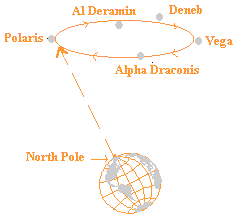NEXA 380 GREEN & LEA
THE EARTH'S ORBIT AND SEASONS
We may represent the earth's orbit around the sun as a circle.
Since the earth is "tilted" as it journeys around the sun, the
pole which is tilted toward the sun has summer while the pole
which is tilted away has winter.

SUMMER IN NORTHERN HEMISPHERE (point A)
SUMMER IN SOUTHERN HEMISPHERE (point c)
Days are longer in summer than in winter. At the "equinoxes" day
and night have equal length. These occur on approximately March
21 and September 23. (points B and D) The position of the sun at
sunset changes too.
PRECESSION OF THE
EQUINOXES
The Earth is not spherical, but has a bulge at the equator.
The Moon and Sun pull on the bulge. Sun and moon lie
approximately in this plane, called the ecliptic. The result is a
motion of the earth that is like the motion of a top: it is called
precession. The rotation axis moves around a circle. The period of
this motion, ie the time to complete one circle, is about 26,000
years.
 To an observer on the earth, it
looks as if the celestial sphere is moving: for example, the pole star
changes. Our present pole star, Polaris, will not be at the North
pole a few thousand years in the future. Notice that precession
causes the celestial equator to move relative to the ecliptic.
Precession causes different constellations to appear on the horizon
at the equinox --as the constellation changes a new "world age"
dawns, e.g.
To an observer on the earth, it
looks as if the celestial sphere is moving: for example, the pole star
changes. Our present pole star, Polaris, will not be at the North
pole a few thousand years in the future. Notice that precession
causes the celestial equator to move relative to the ecliptic.
Precession causes different constellations to appear on the horizon
at the equinox --as the constellation changes a new "world age"
dawns, e.g.
AGE CONSTELLATION ON THE HORIZON
Golden age Gemini, Sagittarius
Silver age Taurus, Scorpio
Copper age Aries
Iron age Pisces
World ages last
about 2000 years.
- The Observation:
- as seen from earth, the planets
occasionally seem to reverse their motion, moving backwards for a
while before continuing on in the original direction.
- Ptolemy's explanation:
- Each planet moves on a small
circle called an epicycle, which in turn moves around the earth
on a big circle.
 In more
advanced versions of the theory, the
earth is not at the center of the circle. By appropriately
arranging the speeds of the motions and the sizes of the circles,
retrograde motion can be simulated.
In more
advanced versions of the theory, the
earth is not at the center of the circle. By appropriately
arranging the speeds of the motions and the sizes of the circles,
retrograde motion can be simulated.
- Modern explanation (since Copernicus)
- The earth and all
the other planets move in orbits around the sun. Planets closest
to the sun complete their orbits in the least time. We observe
the other planets from the moving earth, and retrograde motion
appears as a natural consequence.
The diagram below shows retrograde motion of an outer planet (i.e.
one farther from
the sun than the earth). At times labelled 1, 2, etc. the dots
show the positions of both planets in their respective orbits.
The distance between successive dots is greater for the inner planet
because its speed is greater. Sight lines from the inner plant to the
outer planet show the apparent path of the outer planet, viewed from
the inner, against distant stars. The retrograde motion is
visible between times 5 and 7.

Homework Exercise: draw a
similar diagram for an inner planet viewed from an outer planet,
showing
that retrograde motion arises in that case also. Your diagram should
show sight lines looking inward, toward the sun. Use a compass
and a ruler so that your diagram will be clear and precise.

 To an observer on the earth, it
looks as if the celestial sphere is moving: for example, the pole star
changes. Our present pole star, Polaris, will not be at the North
pole a few thousand years in the future. Notice that precession
causes the celestial equator to move relative to the ecliptic.
Precession causes different constellations to appear on the horizon
at the equinox --as the constellation changes a new "world age"
dawns, e.g.
To an observer on the earth, it
looks as if the celestial sphere is moving: for example, the pole star
changes. Our present pole star, Polaris, will not be at the North
pole a few thousand years in the future. Notice that precession
causes the celestial equator to move relative to the ecliptic.
Precession causes different constellations to appear on the horizon
at the equinox --as the constellation changes a new "world age"
dawns, e.g. In more
advanced versions of the theory, the
earth is not at the center of the circle. By appropriately
arranging the speeds of the motions and the sizes of the circles,
retrograde motion can be simulated.
In more
advanced versions of the theory, the
earth is not at the center of the circle. By appropriately
arranging the speeds of the motions and the sizes of the circles,
retrograde motion can be simulated.